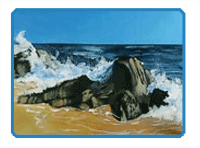
By Matt Fussell
A painting of a seascape should be approached in a similar manner as a typical landscape. The order in which elements are painted is important to the success of the illusion. It is suggested to work from the background to the foreground, layering each section on top of the previous section. For many paintings, this means working from the top of the picture plane, downward.
If the sky is visible, it should be addressed first. Since the middleground and the foreground will be layered above it, the sky should be completed before moving on to the middleground. Of course, minor changes could be addressed in the sky if the need exists, but for the most part, complete the background as much as possible before moving on.
With the background complete, the middleground can be addressed, followed by the foreground. In each instance, complete the section fully before moving on to the next.
Many artists prefer the quick drying times of acrylic paint over the slower drying times of oils. Of course, there are advantages and disadvantages to both media, but one of the clear advantages to a quicker drying time is the ability to work quickly through layers. This allows the artist to build up complex colors quickly as glaze applications of acrylic dry on the surface. Quick drying times also allow the artist to use masking tape and masking fluids to aid in the painting process. Quick tip: Use masking tape to tape off the horizon line where the sea meets the sky to create a strong line. Paint the ocean completely and let dry before removing the masking tape.
Consider the colors that you use in the seascape. Some of the best seascapes use color to create a mood in the painting. Often we focus on matching the colors that we see in our reference without realizing the power of colors that we can control. Cooler colors and tones will lead to subdued, somber imagery, while warmer colors will have the opposite effect. Local colors can be made a bit livelier by simply warming them up or cooling them down. And contrast between shadows and highlights can be enhanced by using complementary versions of colors. For example, orange tinted highlights, with blue tinted shadows.
Creating the illusion of moving water in a painting can prove difficult for beginning artists to master. The frequency of subtle and drastic changes in color value and tonality can be overwhelming to artists. The tendency of the artist is to make attempts at recreating every ripple of water, every splash of foam, and every splatter of sea spray. This, of course is not possible, even for the most highly trained artists. It’s easy for frustration to set in when it is realized that this approach is impossible. Instead, the artist should look for patterns that communicate the illusion of water and seek to recreate these patterns in their painting. A certain pattern of colors and values will translate as waves in the distance, while a certain pattern will translate as waves breaking on the shore.
The following video is excerpts taken from two 1 hour live tutorials demonstrating how to paint a seascape with acrylics…
Recommended Materials for This Tutorial
Golden Heavy Body Acrylics
Nylon Brushes
Masking Tape
Cold Press 140-Pound Watercolor Paper
Here are some more art lessons that you may like...